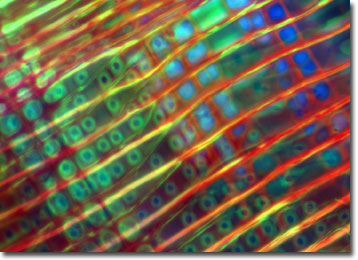Fluorescence Digital Image Gallery
Pine Wood
In 1819, a ship named the Savannah left its home port in Georgia to achieve fame as the first steam powered ship to cross the Atlantic Ocean. It made the journey in 24 hours with the aid of pine wood fuel.

Pine trees are cone-bearing evergreens found worldwide, primarily in northern temperate regions. Typically they have woody stems covered in bark, which protects tissues that conduct nutrients and water. When harvested, they provide materials like lumber, turpentine, rosin, paper, pulp, fuel and even food (pine nuts). Pines are gymnosperms, non-flowering plants that produce naked seeds not enclosed in an ovary. In many pine species, winged seeds are distributed from cones by exposure to wind or fire.
Pine trees are susceptible to infestations of worm-like microorganisms called nematodes, which can cause serious economic damage to tree farms. Nematode infections have a wilting effect on the pines by interfering with the movement of water through the water-conducting tissues. Nematodes are transmitted by wood-boring bark beetles and can affect pines throughout the United States, Canada, Mexico, Japan, China, Taiwan and Korea. Since nematodes feed on growing, dying or dead trees, lumber, crates, wood chips, furniture, and any other pinewood products that are not kiln-dried can also transmit nematodes.
The specimen presented here was imaged with a Nikon Eclipse E600 microscope operating with fluorite and/or apochromatic objectives and vertical illuminator equipped with a mercury arc lamp. Specimens were illuminated through Nikon dichromatic filter blocks containing interference filters and a dichroic mirror and imaged with standard epi-fluorescence techniques. The filter combination utilized for the pine wood was a triple cube specific for DAPI, FITC, and Texas Red. Photomicrographs were captured with a Nikon DXM 1200 digital camera system coupled to the microscope with a lens-free C-mount adapter.
BACK TO THE FLUORESCENCE DIGITAL IMAGE GALLERY
